Members of the family Corvidae, ravens are large, black birds common throughout the northern hemisphere. In many cultures, ravens are associated with ill omens and death. Still, these highly intelligent birds have gained prominence on social media, where people have shared stories of attracting and even befriending ravens.
There are several benefits to attracting ravens. These birds can help keep populations of rodents and other pests at bay. Online anecdotes describe ravens faithfully appearing for daily feedings or bringing gifts to humans. If you’d like to attract ravens to your yard, here are 13 effective methods for you to try.
1. Find a Quiet Spot
Ravens are social with each other, forming flocks that are called an unkindness, but they are often shy around humans and other animals. If you’re aiming to attract ravens to your yard, find a spot that is quiet, away from people, pets, or traffic.
Make sure the area is free from wind chimes, clinking gates, or bells that might scare the birds away. Spend time observing your chosen area to ensure you’ve considered the different factors that might attract or scare off ravens.

Ravens are highly intelligent and have demonstrated an ability to solve complex problems.
©Jessica Guo/iStock via Getty Images
2. Install a Birdbath
Birds of all varieties rely on sources of fresh water for drinking and bathing. Installing a birdbath in your yard is a way to let ravens in your area know that your yard is a welcoming space for them.
Since birds use the water in birdbaths to remove dirt and oil from their feathers, make sure you choose a bath that is large enough to accommodate ravens. These birds weigh an average of 1.5 to 3.5 pounds and can have wingspans of 45 to 50 inches.
Make sure to change the water in your birdbath regularly to prevent the growth of harmful bacteria. Some birds prefer baths with varying depths, so you could experiment with adding rocks to one side of the bath to create a shallow end and a deep end.
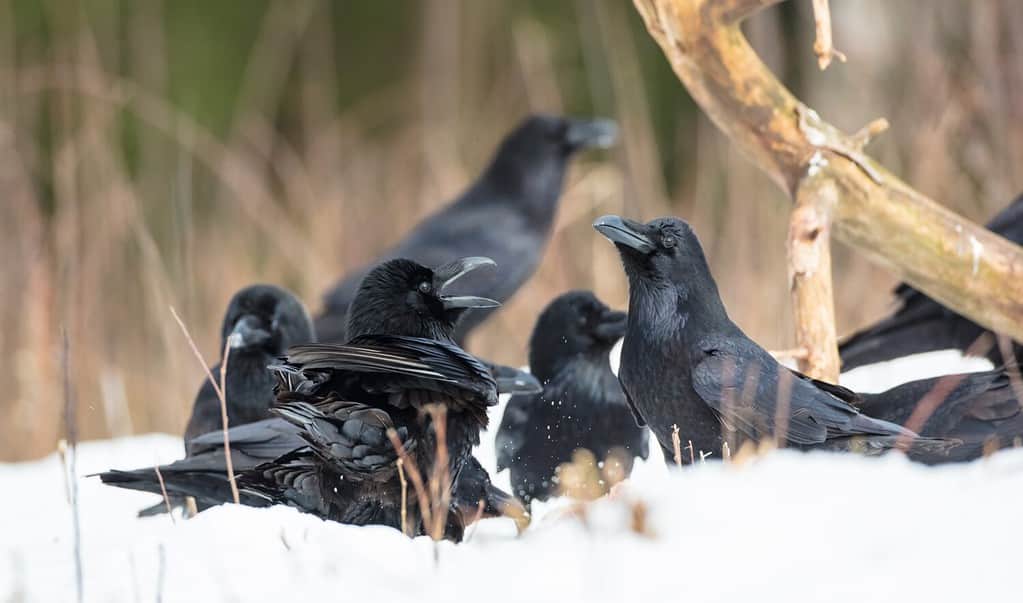
A group of ravens is called an unkindness, a conspiracy, a rave, a treachery, or a flock.
©Simonas Minkevicius/Shutterstock.com
3. Create Space for Roosting
Ravens can generally be found roosting in areas that are close to food and water supplies that allow the ravens to observe the activity around them. They often roost in trees or along power lines.
As you set up space in your yard for ravens, consider if you have any existing areas where the birds could roost. If not, consider erecting a simple structure where they can rest and socialize.
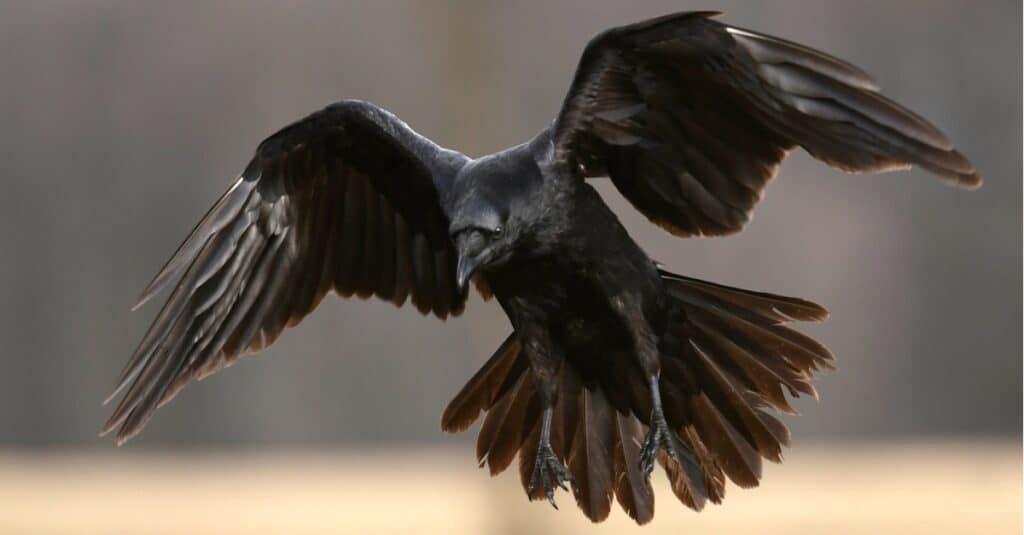
Ravens are strong flyers and can often be seen diving and swooping through the air.
©iStock.com/Piotr Krzeslak
4. Use Decoy Ravens
Decoy birds are generally used to deter animals like squirrels or mice, but in this case, decoy ravens can be used to attract other ravens. These birds are quite social, especially in the winter months when they flock together to find food and shelter.
In groups, ravens adopt nuanced social structures. In general, male ravens have dominance over female ravens, although the highest-ranking males can face challenges from less dominant males. Installing decoy ravens around your yard, especially in the winter, can signal to other ravens that your yard has the food, water, and shelter that they’re looking for.

Ravens choose lifelong mates and, during the winter months, will typically flock together in groups to find food.
©Wright Out There/Shutterstock.com
5. Try Calling for Ravens
Ravens have distinctive calls that range from croaky “kraa” sounds to yelling “haa” sounds. Researchers have found that ravens respond to the calls of other ravens, especially ravens that are familiar.
If you’re not afraid of getting strange looks from your neighbors, you can try imitating a raven’s call yourself. Or, you can purchase a call or use an app to simulate the sound of a raven. This strategy may not attract ravens the first time you try it, but with practice and perseverance, ravens in your area will come to recognize the sound.

Male and female ravens share the responsibility of feeding their chicks.
©J.Copenheaver Photography/Shutterstock.com
6. Keep Your Yard Pet-Free
Ravens will keep their distance if they see that your yard has dogs or cats. Many of the foods that attract ravens will also attract cats and dogs. Ravens will avoid competing for food and risking injury if they can find other sources of food in the area.
Additionally, cats are predators and will hunt unsuspecting birds that land in your yard. If you’re working to make your yard raven-friendly, be sure to keep your dogs or cats safely inside.
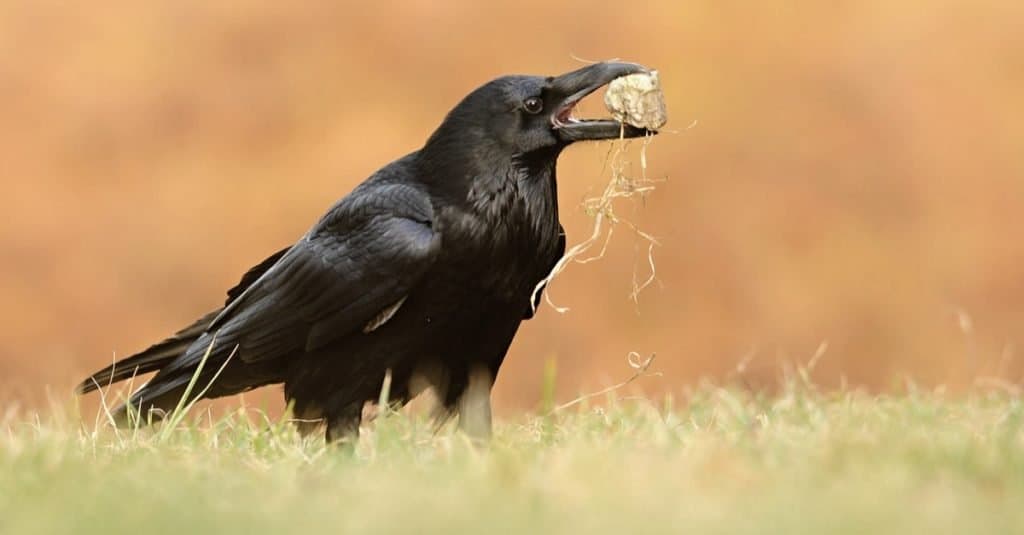
Ravens are adaptable birds and can be found throughout the northern hemisphere.
©Michal Pesata/Shutterstock.com
7. Offer Their Favorite Foods
Ravens are omnivorous, meaning they can eat plant and animal matter. These birds will eat carrion (which doesn’t help their reputations as harbingers of bad luck), but they will also hunt for small reptiles, rodents, and insects.
Fruit and berries are also on the menu for ravens, and they will dig through human garbage bins without shame to find a morsel of food. Try offering unsalted peanuts still in the shell in your yard, other nuts, popcorn, or birdseed.

Unsalted peanuts in the shell are a top choice for attracting ravens.
©iStock.com/White Bear Studio
8. Pick the Right Feeder
There are different styles of bird feeders, each designed to attract a different type of bird. Ravens are larger than most birds and often forage on the ground. You could try putting raven food directly on the grass or try using a platform-style feeder.
If you go with a platform feeder, make sure it is large enough to accommodate the average raven. Ideally, the feeder should be positioned so that ravens in flight will see it, but not in an open area that will feel threatened by predators while they eat.

Ravens are playful birds and have been observed using items like sticks as toys to play with each other.
©Krasula/Shutterstock.com
9. Stick to a Schedule
Once you have a bird feeder, birdbath, and some tasty treats to attract your new avian friends, find a time each day when you will refresh their food supply. Having a consistent time when food appears will make it more likely that ravens will visit your yard.
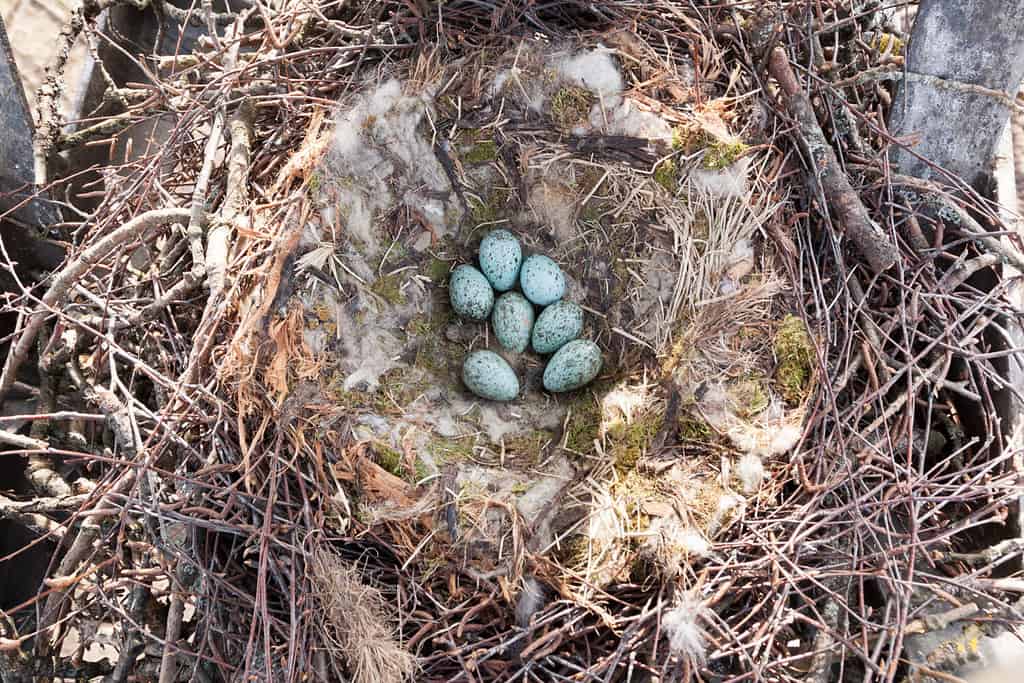
Ravens brood once a year and typically lay three to seven eggs.
©Vishnevskiy Vasily/Shutterstock.com
10. Start a Compost Area
If other attempts to attract ravens haven’t been successful, you could try appealing to their affinity for garbage. Compost is a way to turn your kitchen scraps into nutrient-rich material for your garden, and it can also be a way to attract ravens looking for a steady source of food.
To attract ravens, make sure your compost pile is uncovered and contains a good proportion of vegetable scraps, fruit remnants, and grains. As a bonus, you can add compost to your garden or potted plants as a low-cost source of fertilizer.
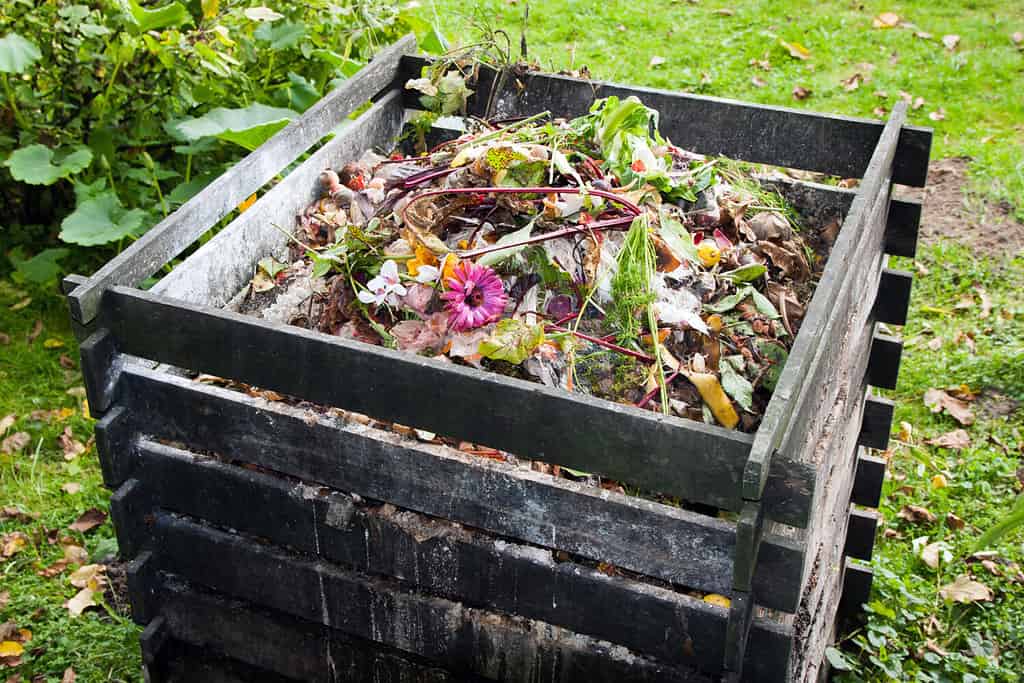
Composting helps to reduce waste and provides vital nutrients for growing plants.
©Evan Lorne/Shutterstock.com
11. Keep Your Distance
Once ravens start to visit your yard, resist the urge to approach them. Ravens are highly intelligent and can recognize individual human faces. You can send ravens the message that you’re safe to be around by providing them with food and water and then backing away to observe from a distance.
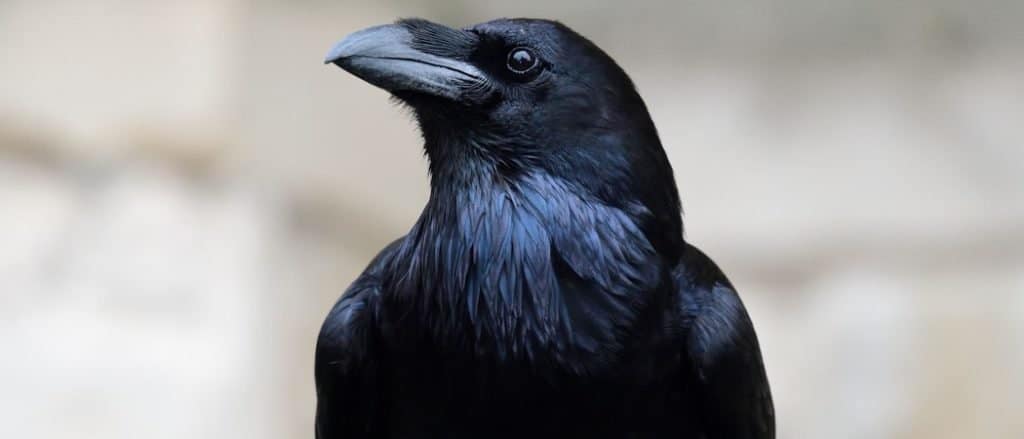
Ravens can remember human faces and have shown the ability to hold a grudge.
©Tom Meaker/Shutterstock.com
12. Set Out Shiny Objects
Ravens are playful birds, and anecdotes on social media suggest that the birds have a fondness for shiny objects, similar to crows (which are also a member of the Corvidae family). To attract ravens to your yard, try placing objects like shiny coins or keys in places where they can catch the sun and the attention of these clever birds.
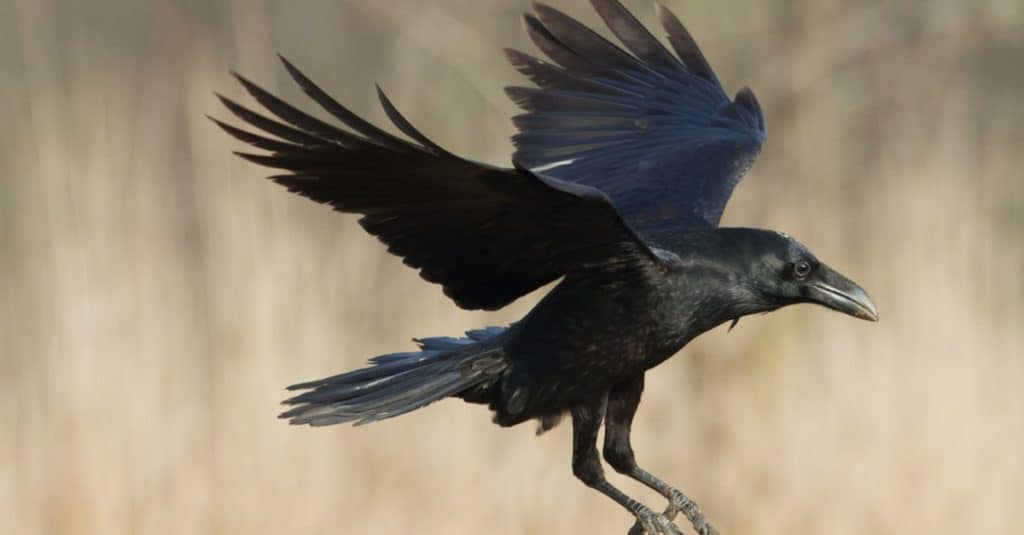
Ravens are opportunistic eaters with diets that range from carrion and bugs to fruits and vegetables.
©Marcin Perkowski/Shutterstock.com
13. Be Patient
While ravens share many characteristics with humans — sociability, curiosity, and playfulness — they are still wild animals and often unpredictable. Take your time when creating a raven-friendly yard and be sure to observe the effects of each change or addition before trying another strategy. With time, consistency, and the right conditions, your yard can become a regular spot for ravens.
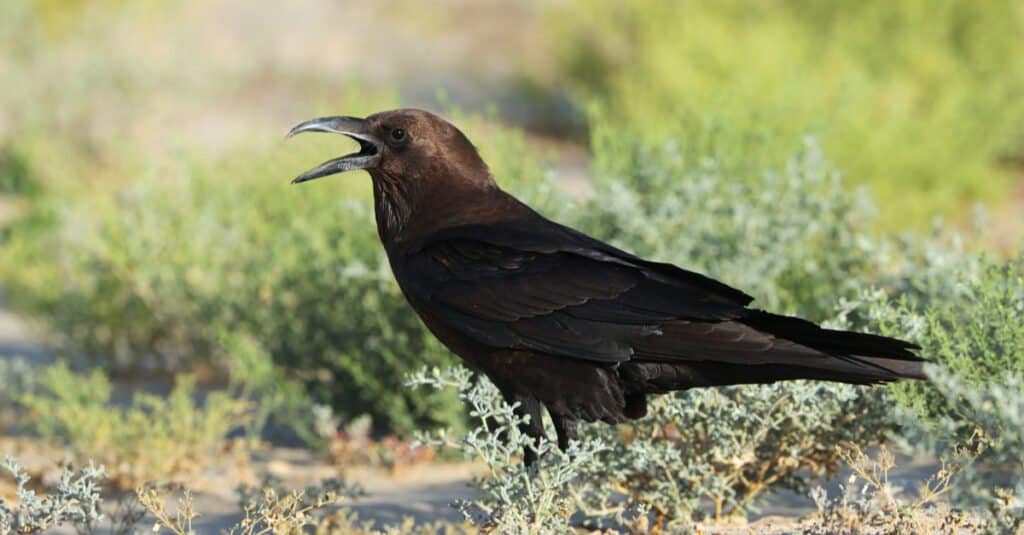
Ravens are considered songbirds, and scientists have recorded as many as 30 unique raven vocalizations.
©Agami Photo Agency/Shutterstock.com
Recap: How to Attract Ravens to Your Yard — 13 Effective Methods & Benefits
| Number | Method | Why It Works |
|---|---|---|
| #1 | Find a quiet spot | Too much noise will scare ravens away. |
| #2 | Install a birdbath | Ravens need sources of fresh water. |
| #3 | Create space for roosting | Ravens look for safe places to rest. |
| #4 | Use decoy ravens | While mostly solitary, ravens do flock together to find food. |
| #5 | Try calling for ravens | Ravens have been shown to respond to each other’s calls. |
| #6 | Keep your yard pet-free | Cats and dogs will scare birds away. |
| #7 | Offer their favorite foods | Ravens will go where it’s easy to find food. |
| #8 | Pick the right feeder | A large feeder is an inviting spot to land. |
| #9 | Stick to a schedule | Ravens respond to consistency. |
| #10 | Start a compost area | Compost allows ravens to scavenge for scraps and bugs. |
| #11 | Keep your distance | Ravens can be shy around humans. |
| #12 | Set out shiny objects | Ravens are known to be playful. |
| #13 | Be patient | It takes time to build trust with birds. |
The photo featured at the top of this post is © Krasula/Shutterstock.com
Thank you for reading! Have some feedback for us? Contact the AZ Animals editorial team.






